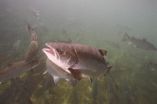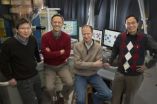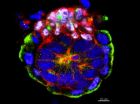(Press-News.org) As the Arctic continues to see dramatic declines in seasonal sea ice, warming temperatures and increased storminess, the responses of marine mammals can provide clues to how the ecosystem is responding to these physical drivers.
Seals, walruses and polar bears rely on seasonal sea ice for habitat and must adapt to the sudden loss of ice, while migratory species such as whales appear to be finding new prey, altering migration timing and moving to new habitats.
"Marine mammals can act as ecosystem sentinels because they respond to climate change through shifts in distribution, timing of their movements and feeding locations," said Sue Moore, Ph.D., a NOAA oceanographer, who spoke today at the annual meeting of the American Association for the Advancement of Science in Chicago. "These long-lived mammals also reflect changes to the ecosystem in their shifts in diet, body condition and physical health."
Moore, who was part of a panel of U.S. and Canadian scientists on the health of marine mammals and indigenous people in the Arctic, stressed the importance of integrating marine mammal health research into the overall climate, weather, oceanographic and social science research on changes in the Arctic.
"Marine mammals connect people to ecosystem research by making it relevant to those who live in the Arctic and depend on these mammals for diet and cultural heritage and people around the world who look to these animals as symbols of our planet's health," Moore said.
INFORMATION:
Additional detail on ecosystem responses to Arctic climate change is available at the NOAA Arctic Report Card web site: http://www.arctic.noaa.gov/reportcard/
For information on the Distributed Biological Observatory, a change detection array that brings together physical and biological observations in the Arctic go to this site: http://www.arctic.noaa.gov/dbo/about.html
For photos of marine mammals go to this NOAA site: https://www.google.com/search?q=NOAA+NMML+photos&client=firefox-a&hs=tCx&rls=org.mozilla:en-US:official&tbm=isch&tbo=u&source=univ&sa=X&ei=uhn5Ut_SGIGirgG6-4D4Bw&ved=0CCYQsAQ&biw=1280&bih=863
NOAA's mission is to understand and predict changes in the Earth's environment, from the depths of the ocean to the surface of the sun, and to conserve and manage our coastal and marine resources. Join us on Facebook, Twitter, Instagram and our other social media channels.
NOAA researcher says Arctic marine mammals are ecosystem sentinels
2014-02-14
ELSE PRESS RELEASES FROM THIS DATE:
Stanford psychologist shows why talking to kids really matters
2014-02-14
Fifty years of research has revealed the sad truth that the children of lower-income,
less-educated parents typically enter school with poorer language skills than their more
privileged counterparts. By some measures, 5-year-old children of lower socioeconomic status
(SES) score two years behind on standardized language development tests by the time they enter
school.
In recent years, Anne Fernald, a psychology professor at Stanford University, has
conducted experiments revealing that the language gap between rich and poor children emerges
during infancy. ...
For understanding family structure to trauma: New technology is yielding bigger data
2014-02-14
Austin - February 13, 2014 - Social media can do more than just entertain us and keep us connected. It also can help scientists better understand human behavior and social dynamics. The volume of data created through new technology and social media such as Facebook and Twitter is lending insight into everything from mapping modern family dynamics to predicting postpartum depression.
"By analyzing different types of social media, search terms, or even blogs, we are able to capture people's thinking, communication patterns, health, beliefs, prejudices, group behaviors – ...
Genetic chip will help salmon farmers breed better fish
2014-02-14
Atlantic salmon production could be boosted by a new technology that will help select the best fish for breeding.
The development will enable salmon breeders to improve the quality of their stock and its resistance to disease.
A chip loaded with hundreds of thousands of pieces of DNA – each holding a fragment of the salmon's genetic code – will allow breeders to detect fish with the best genes.
It does so by detecting variations in the genetic code of each individual fish – known as single nucleotide polymorphisms (SNPs). These variations make it possible to identify ...
Discovery may help to explain mystery of 'missing' genetic risk
2014-02-14
A new study could help to answer an important riddle in our understanding of genetics: why research to look for the genetic causes of common diseases has failed to explain more than a fraction of the heritable risk of developing them.
Susceptibility to common diseases is believed to arise through a combination of many common genetic variants that individually slightly increase the risk of disease, plus a smaller number of rare mutations that often carry far greater risk.
However, even when their effects are added together, the genetic variants so far linked to common ...
Mixed genes
2014-02-14
This news release is available in German. When individuals from different groups interbreed, their offspring's DNA becomes a mixture of the DNA from each admixing group. Pieces of this DNA are then passed along through subsequent generations, carrying on all the way to the present day. Researchers from the Max Planck Institute for Evolutionary Anthropology in Leipzig, Germany, Oxford University and University College London (UCL) have now produced a global map detailing the genetic histories of 95 different populations across the world, spanning the last four millennia.
The ...
Study highlights indigenous response to natural disaster
2014-02-14
DENVER (Feb. 13, 2014) – When a tsunami struck American Samoa in 2009, indigenous institutions on the islands provided effective disaster relief that could help federal emergency managers in similar communities nationwide, according to a study from the University of Colorado Denver and the University of Hawaii at Manoa.
The study found that following the tsunami, residents of the remote U.S. territory in the South Pacific relied on Fa'aSamoa or The Samoan Way, an umbrella term incorporating a variety of traditional institutions governing the lives of its citizens.
"We ...
Berkeley Lab researchers at AAAS 2014
2014-02-14
Can more accurate climate models help us understand extreme weather events? Can we use
synthetic biology to create better biofuels? These questions, and the ongoing search for Dark
Matter and better photovoltaic materials, are just some of the presentations by Lawrence
Berkeley National Lab researchers at this year's AAAS meeting. Here's a quick look at Berkeley
Lab@AAAS:
Friday, Feb. 14
1:00-2:30
Opportunities for New Materials in
Photovoltaics (Toronto Room, Hyatt Regency)
Ramamoorthy Ramesh
The
Department of Energy's ...
Superconductivity in orbit: Scientists find new path to loss-free electricity
2014-02-14
UPTON, NY—Armed with just the right atomic arrangements, superconductors allow electricity to flow without loss and radically enhance energy generation, delivery, and storage. Scientists tweak these superconductor recipes by swapping out elements or manipulating the valence electrons in an atom's outermost orbital shell to strike the perfect conductive balance. Most high-temperature superconductors contain atoms with only one orbital impacting performance—but what about mixing those elements with more complex configurations?
Now, researchers at the U.S. Department of ...
Rewriting the text books: Scientists crack open 'black box' of development
2014-02-14
We know much about how embryos develop, but one key stage – implantation – has remained a
mystery. Now, scientists from Cambridge have discovered a way to study and film this 'black box'
of development. Their results – which will lead to the rewriting of biology text books worldwide
– are published in the journal Cell. Embryo development in mammals occurs in two phases.
During the first phase, pre-implantation, the embryo is a small, free-floating ball of cells
called a blastocyst. In the second, post-implantation, phase the blastocyst embeds itself in the
mother's ...
A role of glucose tolerance could make the adaptor protein p66Shc a new target for cancer and diabetes
2014-02-14
[TORONTO,Canada, Feb 18, 2014] – A protein that has been known until recently as part of a complex communications network within the cell also plays a direct role in regulating sugar metabolism, according to a new study published on-line in the journal Science Signaling (February 18, 2014).
Cell growth and metabolism are tightly controlled processes in our cells. When these functions are disturbed, diseases such as cancer and diabetes occur. Mohamed Soliman, a PhD candidate at the Lunenfeld Tanenbaum Research Institute at Mount Sinai Hospital, found a unique role for ...




